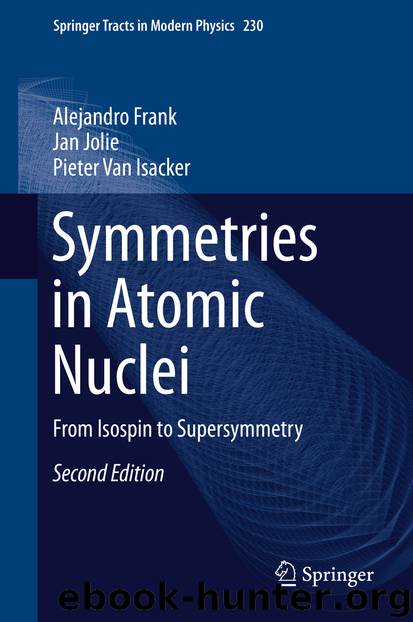Symmetries in Atomic Nuclei by Alejandro Frank & Jan Jolie & Pieter Van Isacker

Author:Alejandro Frank & Jan Jolie & Pieter Van Isacker
Language: eng
Format: epub
ISBN: 9783030219314
Publisher: Springer International Publishing
4.1 The Interacting Boson–Fermion Model
As mentioned in the introduction to this chapter, the IBFM can be thought of, on one level, as a core–particle coupling model with the advantage of a versatile IBM description of the collective core states. However, there are two aspects of the approach which go further. Firstly, as for the IBM in even–even nuclei, it is possible to forge a link between the collective Hamiltonian and the underlying single-particle shell structure. Secondly, symmetries play a central role in the IBFM, just as they do in the boson case. The three symmetries which emerge from the algebraic treatment of the boson problem reappear in the odd-mass formalism although their existence and structure now depends on the single-particle space available to the odd fermion.
The IBFM of odd-mass nuclei was introduced by Iachello and Scholten [231]. Different versions of the model can be constructed depending on the realization of the algebra in terms of creation and annihilation operators. One such realization, called Holstein–Primakoff, leads to a somewhat different version of the IBFM, which is known as the truncated quadrupole phonon–fermion model [232]. The discussion here shall be limited to a brief outline of the basic features of the simplest version of the IBFM.
The basic building blocks of the IBFM are N s and d bosons, in terms of which the even–even core states are modelled, and fermions which occupy a set of single-particle orbits {j, j′, … }. Low-lying collective states of an odd-mass nucleus with 2N + 1 valence nucleons are approximated as N-boson states coupled to a single fermion. The creation and annihilation operators are and b lm for the bosons and and a jm for the fermions, and satisfy the (anti-)commutation relations
Download
This site does not store any files on its server. We only index and link to content provided by other sites. Please contact the content providers to delete copyright contents if any and email us, we'll remove relevant links or contents immediately.
The Complete Stick Figure Physics Tutorials by Allen Sarah(7135)
Secrets of Antigravity Propulsion: Tesla, UFOs, and Classified Aerospace Technology by Ph.D. Paul A. Laviolette(4974)
Thing Explainer by Randall Munroe(3782)
The River of Consciousness by Oliver Sacks(3412)
The Order of Time by Carlo Rovelli(3071)
How To by Randall Munroe(2911)
I Live in the Future & Here's How It Works by Nick Bilton(2839)
A Brief History of Time by Stephen Hawking(2819)
What If?: Serious Scientific Answers to Absurd Hypothetical Questions by Randall Munroe(2542)
The Great Unknown by Marcus du Sautoy(2532)
Midnight in Chernobyl by Adam Higginbotham(2384)
Blockchain: Ultimate Step By Step Guide To Understanding Blockchain Technology, Bitcoin Creation, and the future of Money (Novice to Expert) by Keizer Söze(2379)
Networks: An Introduction by Newman Mark(2264)
The Meaning of it All by Richard Feynman(2213)
Easy Electronics by Charles Platt(2204)
The Tao of Physics by Fritjof Capra(2162)
Midnight in Chernobyl: The Untold Story of the World's Greatest Nuclear Disaster by Adam Higginbotham(2074)
When by Daniel H Pink(2019)
Introducing Relativity by Bruce Bassett(2015)
